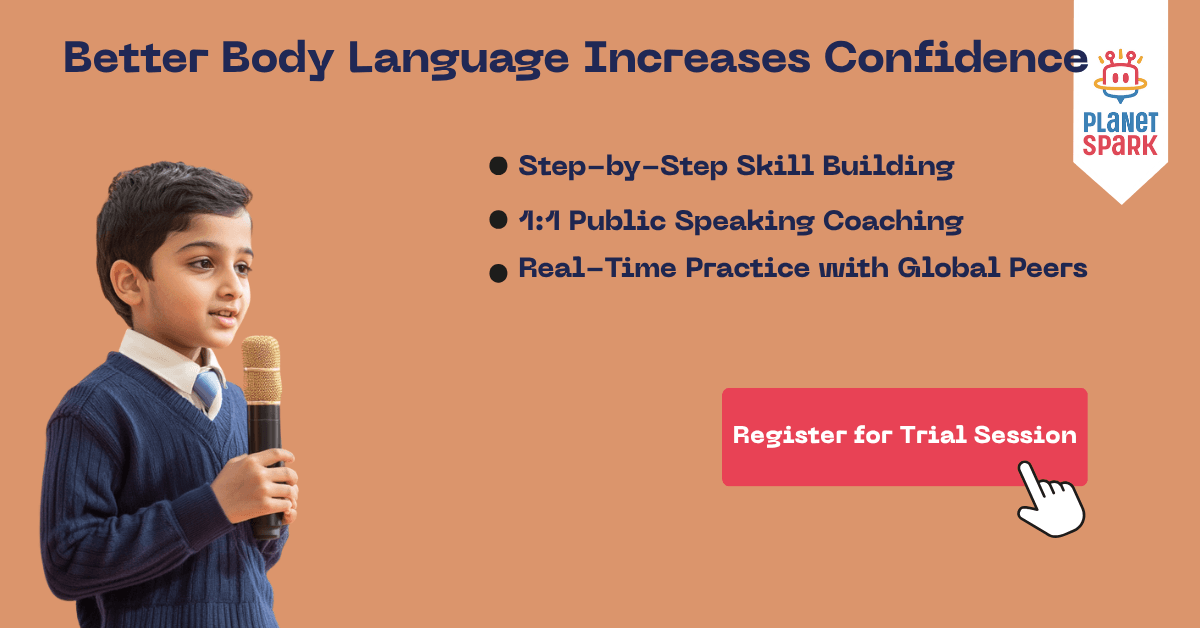Body Language for Kids: Public Speaking Tips & Training

Table of Contents
Public speaking is more than just saying the right words—it’s about confidence, connection, and expression, especially through body language. From posture to gestures and facial expressions, children must learn to communicate non-verbally to succeed in school and beyond. In this guide, you'll discover how to help your child improve their public speaking with practical body language tips and learn how PlanetSpark’s Public Speaking Course provides expert-led support through 1:1 coaching and AI-based feedback tools.
Why Body Language Matters in Public Speaking
Whether your child is narrating a story in class, participating in a debate, or simply answering a question during an online session, how they deliver the message is just as important as what they say. Studies have shown that over 60% of communication is non-verbal.
Key Benefits of Positive Body Language:
- Enhances the impact of words
- Projects confidence and sincerity
- Helps to engage and retain the audience’s attention
- Builds a trustworthy and credible speaker image
- Supports better memory and recall of the content
Even the most brilliant speech can fall flat when the speaker avoids eye contact, fidgets nervously, or lacks expression. On the flip side, even a simple message can become compelling with confident gestures, strong posture, and genuine expressions.

Top Body Language Tips for Public Speaking in Kids
Let’s break down the most critical aspects of body language that every child should learn and practice:
1. Maintain Strong Eye Contact
Eye contact is the quickest way to form a connection with your audience. It:
- Builds rapport and engagement
- Demonstrates honesty and focus
- Encourages the audience to listen more attentively
Training Tip: Ask your child to look just above the audience’s heads if they feel nervous, gradually helping them get comfortable with real eye contact.
2. Use Expressive Facial Expressions
Facial expressions add emotion and clarity to speech. A well-timed smile or a surprised look can add tremendous weight to your child’s words.
- Practice emotions like joy, curiosity, concern, and determination
- Mirror emotions while rehearsing scripts
- Record their speech and watch it back to see which expressions feel natural.
Why It Matters: Audiences subconsciously react more positively to facial expressions that match the tone and message of a speech.
3. Incorporate Meaningful Head Movements
Your child’s head is part of the performance! It can subtly express thoughts and reinforce spoken ideas:
- Nodding indicates agreement or understanding
- Tilting the head shows curiosity or empathy
- Keeping the head still during important parts conveys control and composure
Avoid: Looking down, jerking the head, or turning away from the audience.
4. Embrace Purposeful Hand Gestures
Gestures can clarify complex points, signal transitions, and add flair to delivery. However, excessive or uncontrolled hand movements can be distracting.
Teach your child to:
- Use open-handed gestures to seem approachable
- Point to emphasize but sparingly
- Create visual metaphors (e.g., forming a circle for “unity”)
Practice Idea: Have them rehearse speeches in front of a mirror or record themselves to review their hand gestures.
5. Master the Art of Good Posture
A confident speaker must look the part. Posture communicates confidence, alertness, and energy.
- Teach your child to stand tall with shoulders back
- Keep feet shoulder-width apart for balance
- Avoid leaning on objects or slouching
Posture Practice Tip: Practice standing exercises before speeches to warm up.
6. Control Breathing to Support Presence
Breath control directly influences how children speak and how calm they appear on stage. Shallow breathing can cause nervousness, while deep breathing fosters calm and authority.
- Practice diaphragmatic (belly) breathing
- Teach them to pause and breathe between key points
- Use breathing to slow down speech naturally
Bonus Tip: Practice breathing exercises as a warm-up routine.

Parental Involvement in Body Language Development
Children observe and absorb behaviours from their surroundings. Parents play a significant role in how children perceive and develop body language.
How Parents Can Help:
- Model expressive and open body language during family conversations
- Record videos of your child speaking and review them together
- Organize friendly storytelling or show-and-tell sessions at home
Motivational Reinforcement: Celebrate small improvements and milestones in your child’s speech journey. Your encouragement builds confidence.
PlanetSpark Pro Tip:
Enroll your child in PlanetSpark’s Public Speaking Course to receive expert mentorship from trainers who specialize in teaching confident communication through both verbal and non-verbal expression. Register here for a free class!
How PlanetSpark Builds Confident, Expressive Speakers
1. 1:1 Personal Trainers for Every Child
Every child receives personalized instruction from certified communication experts who:
- Understand the child’s strengths, pace, and personality
- Offer live feedback on body language, vocal variety, and structure
- Use child-friendly teaching methods to build confidence over time
Outcome: Your child receives consistent encouragement and expert support, leading to rapid development.
2. Personalised Curriculum and Learning Roadmap
After a comprehensive assessment, each child receives a learning path tailored to:
- Fill knowledge gaps in grammar, vocabulary, structure, and fluency
- Build public speaking skills step-by-step
- Update regularly based on new goals and milestones
Result: Your child learns at their own pace, always moving forward meaningfully.
3. SparkX – AI-Powered Video Analysis Tool
With SparkX, children upload recorded performances that are analyzed using AI to offer detailed feedback on:
- Body language and posture
- Voice modulation and clarity
- Speech structure and pacing
- Confidence and stage presence
Parents can track growth using objective metrics, ensuring transparency and clarity.
4. AI-Led Practice Sessions
Children get to practice anytime with AI simulations that replicate real-world speaking scenarios. They:
- Deliver speeches to a virtual audience
- Receive instant feedback on grammar and expression
- Refine pacing, emphasis, and confidence levels
5. Spark Diary – Building the Habit of Expression
This integrated digital journal helps children:
- Reflect on daily events and practice expressive writing
- Compose structured speeches and creative stories
- Cultivate clarity, organization, and self-awareness
6. Gamified Learning Modules for Fun Reinforcement
Kids love games—and PlanetSpark makes learning enjoyable through:
- Antonyms Quiz, Word Wisdom for vocabulary
- Listen & Spell and Spell Knockout for spelling
- Grammar Guru Challenge for engaging grammar drills
These elements boost attention, retention, and engagement.
7. Structured Parent-Teacher Meetings (PTMs)
Stay involved in your child’s journey with regular PTMs that:
- Provide data-backed progress reports
- Discuss personalized strategies for improvement
- Strengthen collaboration between trainer and parent
8. Comprehensive Progress Reports
Each report evaluates:
- Content quality, voice clarity, body language
- Grammar and syntax usage
- Confidence and stage presence
- Delivery structure and coherence
Bonus: Every report includes trainer comments and actionable next steps.
9. Exclusive Learning Clubs and Creative Communities
Children thrive when they collaborate with peers. PlanetSpark Clubs include:
- Debate Club: Build logical thinking and persuasive arguments
- Speech Circles: Refine delivery in a judgment-free zone
- Podcasting Club: Create and publish kid-friendly podcasts
- Writers Guild: Share, critique, and co-create stories
10. Sparkline – PlanetSpark’s Safe Sharing Platform
On Sparkline, kids can:
- Publish speeches, stories, or poems
- Comment and appreciate peer content
- Grow digital presence in a secure, moderated space
11. Regular Competitions and Recognition Events
PlanetSpark keeps kids motivated through:
- Themed speech and storytelling contests
- Public showcases and podcast exhibitions
- Talent hunts with exciting prizes and online features
12. SparkBee – Daily Grammar and Vocabulary Practice
SparkBee turns practice into play. With daily interactive quizzes, kids:
- Reinforce grammar, spelling, and vocabulary
- Earn badges and rewards
- Build strong foundational skills
13. SparkShop – Curated Digital eBooks
SparkShop offers an engaging collection of:
- Class-wise eBooks on grammar, writing, and comprehension
- Interactive lessons and activities
- Affordable, accessible digital learning content
Final Thoughts: Body Language Unlocks Communication Confidence
A well-structured speech is only effective when paired with confident, controlled, and expressive body language. By helping your child master posture, gestures, facial expressions, and eye contact, you're empowering them to shine—not only on stage but in every area of life.
With PlanetSpark’s comprehensive and engaging platform, your child receives:
- Individualised training
- AI-backed performance insights
- Fun and meaningful daily practice
- Supportive peer learning communities
Give your child the gift of powerful communication. Join PlanetSpark’s Public Speaking Program today, register here!
Frequently Asked Questions (FAQs)
1. What age group is PlanetSpark’s Public Speaking course designed for?
A: PlanetSpark caters to children aged 4–16, with content and lessons tailored to suit developmental stages and interests.
2. My child is very shy—will this work for them?
A: Yes! Our 1:1 sessions are designed to build trust and confidence gradually. Even reserved children grow expressive in this supportive environment.
3. What is the frequency of classes?
A: Typically, children attend 2–3 sessions per week, though scheduling is flexible based on your child’s needs and trainer availability.
4. Are PlanetSpark trainers certified?
A: Absolutely. All trainers are certified and trained in child-focused communication techniques and teaching methods.
5. What if we need to reschedule a class?
A: No problem! We offer flexible rescheduling options through the parent dashboard.
6. How do I stay updated on my child’s progress?
A: You will receive detailed reports, attend regular PTMs, and get access to SparkX performance videos and data.
7. Is there a trial class available?
A: Yes! You can sign up for a free trial class and explore the full experience.
Personalized Communication Report
Record a video to get a AI generated personalized communication report for your child

Hi There, want to try these
tips for your child with
LIVE with our expert coach?
Let's check your child's
English fluency
